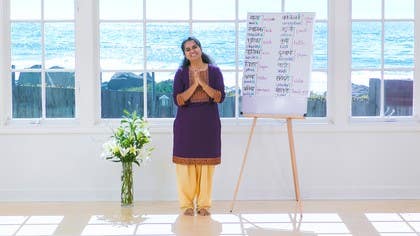Description
About This Video
Transcript
Read Full Transcript
Namaste friends. I'm so happy that we are exploring these different words of the Sanskrit language together. We looked at some from the masculine gender ending with aha. Next we had a few words in the feminine ending with aa and ee and then we had a few words in the neuter ending with um. We heard the sounds of the word. We looked at the objects they correspond to and now let's see how you would write them out. So we look at the masculine gender first. We had the word glass, cha sha kaha and this is what it would look like. Cha sha kaha. It's the cerebral sha. So cha sha kaha. It's a good thing if you can train your tongue right from the beginning to get the sound correct. The position of the sound. Alright. The next word for spoon is cha ma saha. Yes. So cha ma saha. In the transliteration cha ma saha. Very nice. The word for brush is kur cha ha. Kur with the long u, rr cha ha, kur cha ha, kur cha ha. In transliteration the bag is su ta ha. Half su with a y and an u su ta ha. In transliteration su ta ha. The fork kanta kaha. That's what it looks like. Kanta kaha. Kanta kaha. A mat is kata ha. Kata ha. The dot below in the transliteration represents the cerebral so kata ha. Then we have just a few body parts. So the important one the hand is ha su ta ha, ha su ta ha, ha su ta ha. Great. The foot is pa dha, pa dha, pa dha. Now I would tend to do the pa dha just to emphasize on that ending. But you could just say pa dha. It just have to be more clear. Then father when exploring relationships was jana kaha, jana kaha. There we go. Jana kaha, jana kaha. Brother sa ho da raha who shares the same belly space. sa ho da raha, sa ho da raha. And then mantra. You are familiar with that already. But this is how it would look like. And just notice that the nna which actually has a single stick drops the stick and sort of enters into the belly of the thra. So that's mantra ha. Great. And that's the simple transliteration and a very important breathing exercise known as prana yamaha. I want you to pay special attention to this because it is a word that's commonly used. And you just need to listen to the rhythm of that sound, the length of the vowels in that. So it's prana yamaha. Enjoy the pause in the breath, the long vowels in that word. So there we are. We have a few masculine words here. But what you would recognize is the sound aha at the end of it. So practice it.
And like I would suggest what you can do is to bring in a little Sanskrit atmosphere in your house. Maybe next time you sit down for a meal, instead of saying pass me the spoon, you would say pass me the chamma saha. How's that? Try it out and enjoy it. Thank you.







You need to be a subscriber to post a comment.
Please Log In or Create an Account to start your free trial.